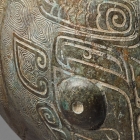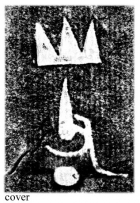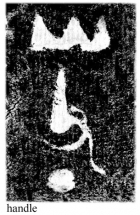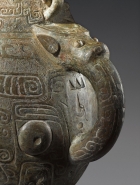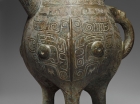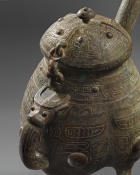J.J. Lally & Co., Oriental Art / New York City, New York
MenuPast Exhibition
Chinese Archaic Bronzes:
The Collection of Daniel Shapiro
March 14 - April 5, 2014
6.
HE 盉
Shang Dynasty, 12th – 11th Century B.C.
with upright rounded trilobed body tapering down to three solid columnar legs, decorated on each lobe with an elaborate taotie in flat relief with large round bulging eyes centered by a narrow flange under wide bovine horns, the details of the taotie boldly drawn in broad outlines and reserved on a dense ground of fine spiral scroll, the sloping shoulder with a frieze of kui dragons reserved on the same fine linear scroll ground, the short constricted neck rising to an everted rim with bevelled edge, fitted with a domed cover decorated with three smaller versions of the same horned taotie on the body of the vessel but facing upwards towards a nippled half-round finial on a short stem, the high angled tubular spout decorated with intaglio cicada-blades and a band of linked ‘C’- scrolls, rising from the shoulder opposite the rounded loop handle decorated with spurred curls and surmounted by a bovine head cast in the round with protruding eyes, pointed ears and blunt horns, below a small loop fitted with a double-ringed link connected to the loop on the cover, the smooth surface with thin patination of even reddish-brown tone showing widely scattered small areas of bright malachite green, cast with an inscription of three pictograms under the handle, repeated under the cover.
Height 12 1⁄2 inches (31.7 cm)
The inscription may be read as 山父丁 (shan fu ding)
Provenance
Formerly in a European Private Collection
Christie’s New York, 21 September 2004, lot 149
J. J. Lally & Co., New York, 2004
A he of very similar form decorated in the same style with a closely related program of taotie and kui dragons, known as the Fu ding he, in the National Palace Museum, Taipei, is illustrated in Shang Ritual Bronzes in the National Palace Museum Collection, Taipei, 1998, pp. 164–167, no. 11.
Compare also the he of similar form cast in relief with similar horned taotie and kui dragons, in the collection of the Asian Art Museum of San Francisco illustrated by d’Argencé, Ancient Chinese Bronzes in the Avery Brundage Collection, San Francisco, 1977, pp. 22–23, pl. VI.
商 山父丁盉 高 31.7 厘米
